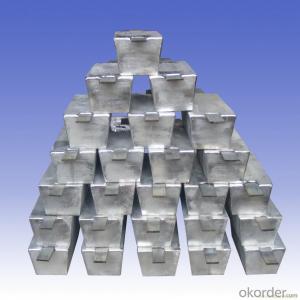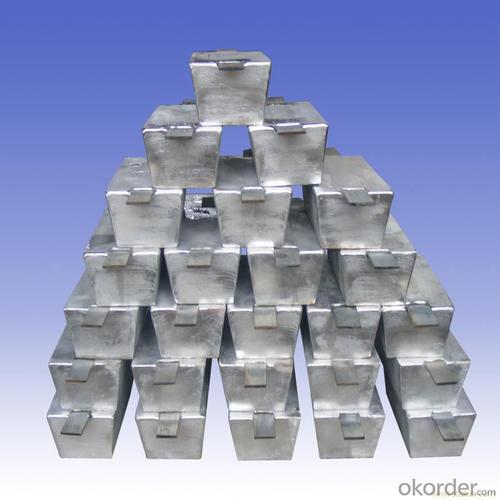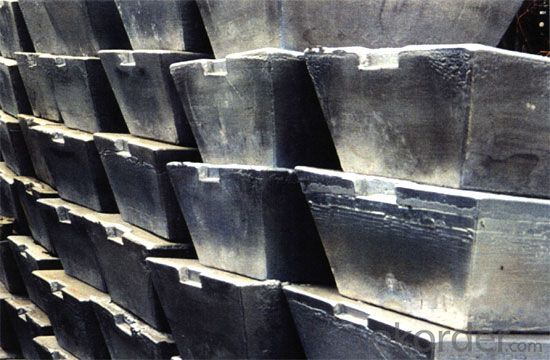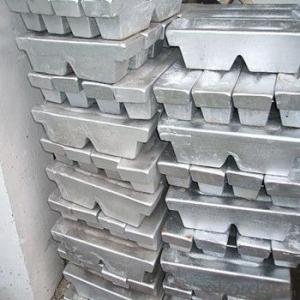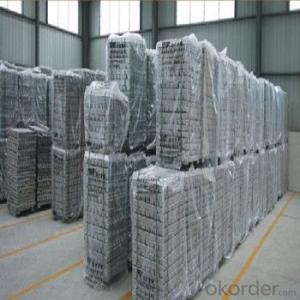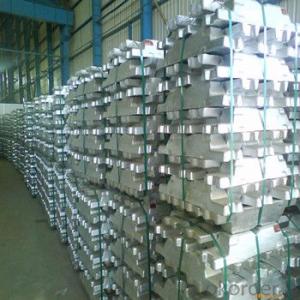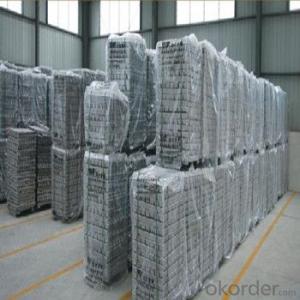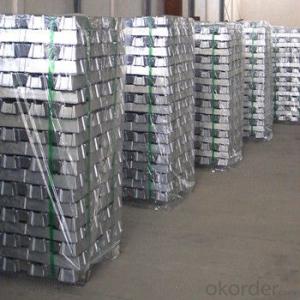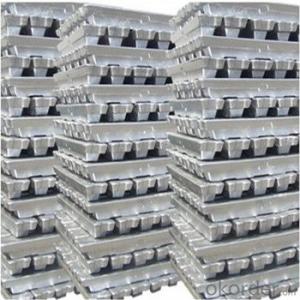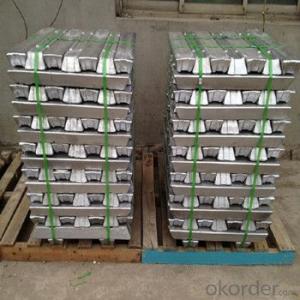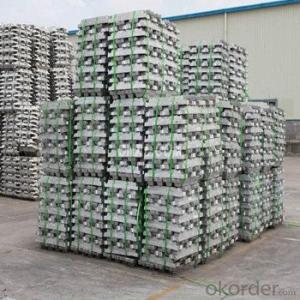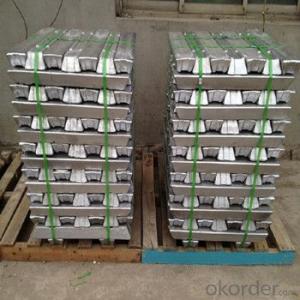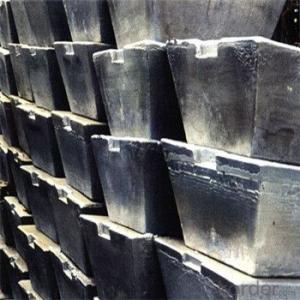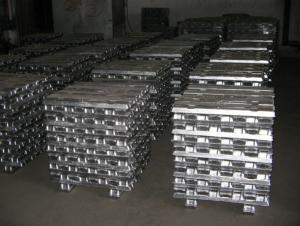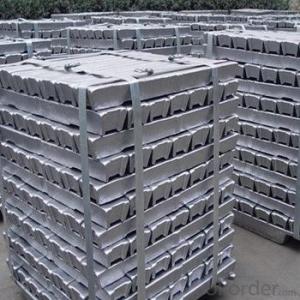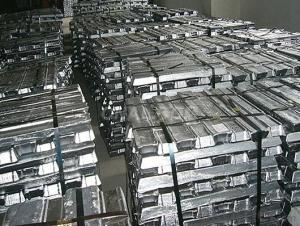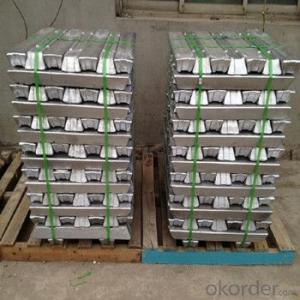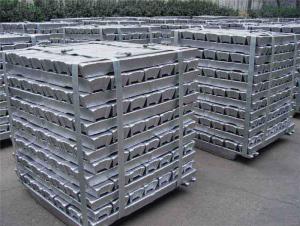Aluminium Ingot Pure 99.7% With High Quality National Standard
- Loading Port:
- China main port
- Payment Terms:
- TT OR LC
- Min Order Qty:
- 1000 m.t.
- Supply Capability:
- 10000 m.t./month
OKorder Service Pledge
OKorder Financial Service
You Might Also Like
Pure Aluminum Ingot Used for Industry
1.Structure of Aluminum Ingot Description
A material that has been cast into a shape in order to be transported and processed easier than in an unprocessed form. An ingot is typically rectangular in shape, which allows it to be stacked. Ingots are most commonly associated with metals, with ingots of gold held in the vaults of banks and brokerages being popular images.
.
2.Main Features of the Aluminum Ingot
•High Purity
•Easy operation
•High strength
•Fast melting
•Competitive price
•Best Service
3. Aluminum Ingot Images

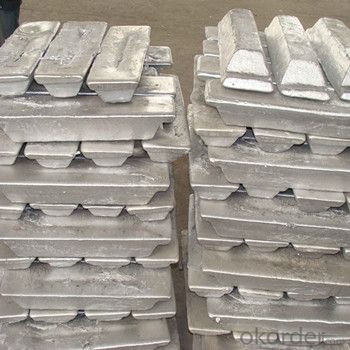
4. Aluminum Ingot Specification
Grade | Chemical Composition % | |||||||||
Al≥ | impurities ≤ | |||||||||
Si | Fe | Cu | Ga | Mg | Zn | Mn | others | Sum | ||
Al99.9 | 99.90 | 0.50 | 0.07 | 0.005 | 0.02 | 0.01 | 0.025 | - | 0.010 | 0.10 |
Al99.85 | 99.85 | 0.80 | 0.12 | 0.005 | 0.03 | 0.02 | 0.030 | - | 0.015 | 0.15 |
Al99.7 | 99.70 | 0.10 | 0.20 | 0.010 | 0.03 | 0.02 | 0.030 | - | 0.030 | 0.30 |
Al99.6 | 99.60 | 0.16 | 0.25 | 0.010 | 0.03 | 0.03 | 0.030 | - | 0.030 | 0.40 |
Al99.5 | 99.50 | 0.22 | 0.30 | 0.020 | 0.03 | 0.05 | 0.050 | - | 0.030 | 0.50 |
Al99.00 | 99.00 | 0.42 | 0.50 | 0.020 | 0.03 | 0.05 | 0.050 | - | 0.050 | 1.00 |
5.FAQ of Aluminum Ingot
We have organized several common questions for our clients,may help you sincerely:
①How about your company?
A world class manufacturer & supplier of castings forging in carbon steel and alloy steel,is one of the large-scale professional investment casting production bases in China,consisting of both casting foundry forging and machining factory. Annually more than 8000 tons Precision casting and forging parts are exported to markets in Europe,America and Japan. OEM casting and forging service available according to customer’s requirements.
②How to guarantee the quality of the products?
We have established the international advanced quality management system,every link from raw material to final product we have strict quality test;We resolutely put an end to unqualified products flowing into the market. At the same time, we will provide necessary follow-up service assurance.
③How long can we receive the product after purchase?
In the purchase of product within three working days, We will arrange the factory delivery as soon as possible. The pecific time of receiving is related to the state and position of customers.Commonly 7 to 10 working days can be served.
- Q: What is an aluminum ingot?
- A solid block or bar of pure aluminum metal, known as an aluminum ingot, is created by casting or molding it into a specific shape. The ingot is typically obtained through the smelting process, which involves heating aluminum ore at high temperatures to extract the metallic aluminum. Once the molten aluminum is acquired, it is poured into molds and allowed to cool and solidify, resulting in the formation of the ingot shape. These ingots generally have a rectangular shape with flat, smooth surfaces. They find extensive use in different industries, particularly in the manufacturing of aluminum products like foil, sheets, rods, wires, and extrusions. Moreover, the ingots act as the raw material for further processing and can be melted down and reformed multiple times, making them highly valuable within the recycling industry. Aluminum ingots are renowned for their lightweight nature, resistance to corrosion, and high strength-to-weight ratio properties. Consequently, they are the preferred choice for a wide range of applications, including aerospace, automotive, construction, and packaging.
- Q: Difference between ingots and alumina
- Our daily industrial material called aluminum ingots, it is made of alumina cryolite by electrolysis aluminum is produced. The standard containing 99.7% aluminum ingots, registered in the London market is it.
- Q: How are aluminum ingots used in the production of architectural structures?
- Due to their numerous advantageous properties, aluminum ingots find widespread usage in the production of architectural structures. They serve as the raw material for manufacturing various aluminum products, such as beams, columns, façades, and roofing systems. One of the primary rationales for employing aluminum ingots in architectural structures lies in their lightweight nature. Aluminum is considerably lighter than conventional construction materials like steel or concrete. This characteristic facilitates the transportation, handling, and installation of finished architectural components, thereby reducing overall construction time and costs. In addition, aluminum ingots possess exceptional corrosion resistance. When exposed to the elements, aluminum develops a natural oxide layer that shields it from rust and decay. This property ensures the longevity and visual appeal of architectural structures made from aluminum ingots, even in harsh environments. The versatility of aluminum ingots also plays a pivotal role in architectural applications. Aluminum can be readily extruded, cast, or molded into various shapes and profiles, enabling architects and designers to fashion unique and intricate structures. This flexibility allows for the production of custom-made components that fulfill specific design requirements, thereby enhancing the aesthetic appeal of the structures. Furthermore, aluminum ingots offer excellent thermal and electrical conductivity. This feature proves particularly advantageous in architectural structures as it facilitates efficient energy transfer and distribution. Aluminum components can be seamlessly integrated into heating, ventilation, and air conditioning systems, ensuring optimal energy efficiency and cost savings. Moreover, aluminum ingots demonstrate high sustainability and environmental friendliness. Aluminum is 100% recyclable without compromising its original properties, making it the preferred choice for eco-conscious architects and builders. By incorporating aluminum ingots into architectural structures, the construction industry can significantly reduce its carbon footprint and contribute to a more sustainable future. In conclusion, the many benefits of aluminum ingots, including their lightweight nature, corrosion resistance, versatility, thermal and electrical conductivity, and sustainability, make them highly suitable for the production of durable, visually appealing, and energy-efficient architectural structures that meet the demanding requirements of modern architecture.
- Q: A ton of scrap melting into pure aluminum ingot to sell how many pure profit 11 tons of aluminum melts much pure aluminum removal processing fees and all other costs of artificial coal freight
- First, clear, pure aluminum can be Aluminum Alloy, but Aluminum Alloy cannot do pure aluminum; aluminum can only generate Aluminum Alloy, cannot generate pure aluminum. The landlord asked too general, scrap types are more complex, there can be no introduction, to scrap aluminum alloy doors and windows processing factory as an example, the scrap aluminum is 95%-96%, recovery to clean without plastic film without iron aluminum can be up to 93%-94%, the more serious oxidation of impurities can only 90% following this, the price difference between the landlord should be aware of it, but this is just a scrap material, there are many types, can be said that every time you buy the cost of raw materials will change.
- Q: How are aluminum ingots used in the production of electrical connectors?
- Due to their excellent conductivity and lightweight properties, aluminum ingots are commonly used in the production of electrical connectors. Initially, the ingots are melted and cast into specific shapes, such as bars or rods, which are then further processed to form the connectors. One major advantage of aluminum ingots is their high electrical conductivity. Aluminum is an exceptional conductor of electricity, enabling efficient transmission of electrical signals in various applications. This makes it an ideal material for producing connectors that require the smooth flow of electricity without significant resistance or loss. Furthermore, aluminum ingots offer lightweight characteristics compared to other materials like copper. This lightweight property is particularly advantageous for electrical connectors as it facilitates easier installation, handling, and transportation. The reduced weight also helps minimize strain on electrical systems and devices. The production of electrical connectors involves melting the aluminum ingots and casting them into specific shapes using various casting techniques. These shapes can range from bars and rods to intricate designs, depending on the requirements of the connectors. The ingots then undergo further processing through machining, extrusion, or other shaping methods to achieve the desired dimensions and features. After shaping, the aluminum connectors undergo additional processes such as surface treatment or coating to enhance their performance and durability. This may involve plating the connectors with materials like silver or tin to improve conductivity or applying protective coatings to prevent corrosion. In summary, aluminum ingots are essential in the production of electrical connectors as they provide a reliable and efficient material that meets the demands of modern electrical systems. Their excellent conductivity, lightweight nature, and versatility make them the ideal choice for a wide range of electrical connector applications.
- Q: How is aluminum ingot different from aluminum billet?
- Aluminum ingots and aluminum billets are two variations of aluminum metal that vary in terms of their form, dimensions, and manufacturing techniques. Typically, aluminum ingots are produced through a primary aluminum production method known as smelting. These ingots are solid blocks or slabs of aluminum with a standardized shape and size, resembling a large rectangle. The production process involves pouring molten aluminum into a mold and allowing it to cool and solidify. Aluminum ingots serve as essential raw materials for subsequent processing, including rolling, extrusion, or forging, enabling the creation of diverse aluminum products. On the other hand, aluminum billets are semi-finished goods that are often derived from aluminum ingots. The creation of billets involves heating and continuously casting molten aluminum into a cylindrical form, which is then cooled and solidified. Unlike ingots, billets possess a smaller cross-sectional area and a longer length. They are primarily employed as starting materials for extrusion processes. In these processes, billets are heated and pushed through a die, enabling the production of intricate shapes such as rods, bars, profiles, or tubes. In conclusion, despite being composed of the same material, aluminum ingots and aluminum billets differ in their form, dimensions, and purpose. Ingots serve as large rectangular blocks, utilized as raw materials for further processing, while billets are smaller cylindrical shapes employed as the initial materials for extrusion processes.
- Q: How are aluminum ingots used in the production of doors and windows?
- Aluminum ingots play a crucial role in the production of doors and windows due to their inherent properties and versatility. These ingots are first melted down to create molten aluminum, which is then used to produce various door and window components. One of the primary uses of aluminum ingots is in the extrusion process. Extrusion involves forcing the molten aluminum through a specially designed die to create continuous profiles of various shapes and sizes. These profiles form the basis of door and window frames, sashes, mullions, and other structural elements. The extrusion process allows for great design flexibility, enabling manufacturers to create intricate and lightweight profiles that meet specific requirements. Additionally, aluminum ingots are used to produce hardware components such as handles, locks, hinges, and fasteners. These parts are essential for the proper functioning and security of doors and windows. Aluminum's lightweight yet durable nature makes it a preferred choice for such hardware, as it offers strength without adding unnecessary weight to the final product. Furthermore, aluminum ingots are also used in the production of door and window panels. These panels can be made from aluminum sheets, which are formed, cut, and assembled to create the desired design. Aluminum panels offer excellent thermal and sound insulation properties, making them energy-efficient and capable of reducing external noise. The use of aluminum ingots in the production of doors and windows brings several benefits. Firstly, aluminum is highly resistant to corrosion, ensuring that the finished products will maintain their appearance and functionality over time. Secondly, aluminum is a lightweight material, making the doors and windows easier to handle and install. Thirdly, aluminum is a sustainable and recyclable material, aligning with the growing demand for environmentally friendly products. In conclusion, aluminum ingots are extensively utilized in the production of doors and windows. From forming extruded profiles to manufacturing hardware components and panels, aluminum's unique properties make it an ideal material for creating durable, lightweight, and aesthetically pleasing products.
- Q: Wall aluminum window price
- Now there are all aluminum furniture, aluminum materials, for more information, you can point me
- Q: What kinds of aluminum alloy material are used in casting?
- The surface quality of aluminum profile is also difficult to overcome: warping, deformation, black lines, concave convex and white lines. Designers with high levels and reasonable mold design and production process can avoid the defects are not obvious. Inspection defects shall be carried out in accordance with national inspection methods, that is, sight distance 40~50CM to discriminate defects.
- Q: What kind of material is die casting aluminium ingot?
- Product (Unwrought). Products obtained by smelting (or refining) and casting. For example, rolled ingots, extruded ingots, wrought ingots, and remelting ingots
Send your message to us
Aluminium Ingot Pure 99.7% With High Quality National Standard
- Loading Port:
- China main port
- Payment Terms:
- TT OR LC
- Min Order Qty:
- 1000 m.t.
- Supply Capability:
- 10000 m.t./month
OKorder Service Pledge
OKorder Financial Service
Similar products
Hot products
Hot Searches
Related keywords
